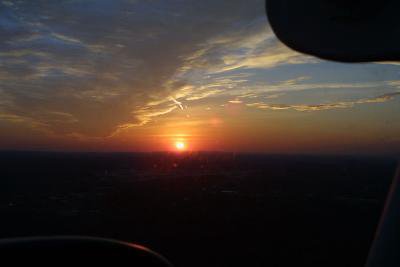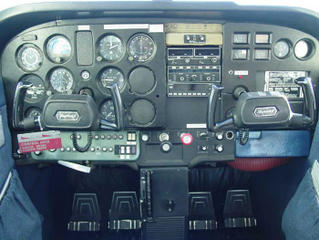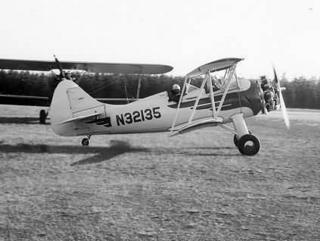There I was...
My flying career is still in its infancy, but I've had a couple of, well let's just say "interesting" moments, little episodes that to me, anyway, stand out as memorable. If you're a CFI, a freight dog or a commercial pilot with a big fat logbook, these will most likely seem mundane to you. But to me as a low time pilot, each was an important learning experience.
The first, and perhaps most memorable one, happened when I had a measely 25 hours of total time. I had just soloed for the first time a few weeks before and completed my three supervised flights alone in rapid succession. Now with an endorsement from my instructor in my logbook, I was free to go up alone almost any time I wanted. So on this beautiful Saturday morning I took to the skies to practice stalls, steep turns and ground reference maneuvers.
The short 15nm trip to the practice area was quite enjoyable. I flew about a thousand feet under a broken cumulus ceiling, admiring the majestic white formations above and wishing I could punch through them and skim their tops. Over the Wachuset Reservoir, I executed a couple of clearing turns, then practiced two power-off and two power-on stalls. I was pleased with my recovery of the latter, as I managed to minimize any sort of wing drop. Descending to 1,000 AGL, I began describing circles around a silo on the ground, then made S-turns over a railroad that runs paralel to the reservoir.
The day was just turning to be exceptional. My flying was good and I was having a hell of a time up there on my own.
As the end of the block approached, I headed back at to KBED at 3,000. Haphazard rays of sunlight broke through the blanket of clouds above and painted a curious pattern of bright emerald green patches on a darker shaded canvass of fields and forests. A thin veil of haze stuck to the horizon and wrapped itself around Boston in an eerily beautiful way just a few miles to my east.
I was in heaven.
A few miles out of Bedford, I began my descent to PTA. Then, out of the blue, the world around me began to shake violently. I uttered a brief expletive and realizing the engine was the culprit almost instinctively ran through the emergency checklist I'd practiced with my CFI so many times: fuel selector valve on both, mixture full rich, carb heat on, primer in and locked. Hmm, everything seemed ok, yet the engine would disagree. It ran so rough that I grew increasingly concerned about the vibration inflicting structural damage to the 172.
A magneto check revealed nothing wrong there either.
About 5 miles out of Bedford, I knew I could make the field but was still concerned about the terrible shaking and briefly considered killing the engine to avoid having it tear itself off the front of the plane. That would definitely not help.
I fiddled with the mixture in an attempt to sooth the engine, but it seemed to do nothing.
With all known options exhausted I resigned myself to call tower and explained the problem. I didn't declare an emergency but was hoping he would give me priority landing. I had two trainers ahead of me on downwind: one of them carrying my CFI, who was no doubt monitoring the situation.
Before I even released the mic switch, the vibration subsided and all went back to normal. Refusing to take any chances, I took the controller up on his offer for priority landing, put the aircraft down safely and brought it back to the ramp.
At no point during the flight had I felt scared, but I sat in the cockpit for a minute, relieved. My CFI, who had landed shortly after me, came running up to me with a smirk on his face.
"So what did you do?" he asked jokingly.
When I described what had happened, his jaw dropped and I could see in his eyes that this could have had a much more serious outcome. He had probably thought I'd forgotten to put the carb heat on after chopping power, or that perhaps I hadn't pushed the mixture back to full rich after leaning at altitude.
I reported the problem to dispatch but the maintenance crew was unable to replicate the problem. Two weeks later, during a checkride, a student and our DE declared an emergency when the same problem arose. The verdict, a couple of days later: cracked cylinder.
A little later on the day of that flight, I felt some belated fear. It suddenly dawned on me that had the problem arisen further out, or while I was low over the ground practicing GRMs, I might not have made the airport and our area offers precious few off-airport landing options because it is so densely wooded. The experience, however, also showed me my CFI's training was taking hold in that little brain of mine. The checklist came to me almost insintively and I didn't suffer from that deer-in-the-headlights reaction. Thanks Tyler!
The next couple of stories concern mid-air collisions, the potential of which is alarmingly high in this area on nice summer days because there's just so much darn traffic.
The first instance occured with my CFI on board. We had just taken off from 29 at KBED. At 500AGL, I began my turn on a left crosswind when I suddenly found myself only feet off the left wing of a 172 on an extremely close left downwind. I quickly ducked to the right while my instructor berated the pilot of the other '72. Turns out he'd reported himself northwest of the field instead of southwest and was therefore cleared by tower to enter the right downwind, NOT the left.
On the day of my 28th birthday, just weeks after I passed my checkride, I left work early to go for a leisurely cross country flight. I took off in somewhat hazy conditions, which are the norm here in the Northeast during the summer. I headed northeast toward the North Shore and stayed below Boston's Bravo. I skirted the beautiful New Hampshire and Maine shores, then headed inland direct Kennebunk VOR and hung a left turn on a long final to 25 at KSFM. After a touch and go, I called Boston Approach for flight following but the controller appeared busy. I decided to give him a few minutes and scanned the sky around to avoid any unpleasant encounters with other flying machines. Suddenly, a white flash caught my attention to the left. I turned my head to see a Piper Arrow pass just under me from my 5 o'clock position to my 11 o'clock. He was 100ft or less below me, giving me a hell of a scare. Whether he saw me or not remains a mystery. Seeing it was a low-wing, I doubt he could've missed me, but then again why would he have crossed my path so close?
I called Boston and got flight following in a jiffy.
My final story today is more amusing. A few months ago, I headed out west aimlessly on a great overcast day. I say great because the cloud cover provided smooth clean air, which made the flight extremely enjoyable. Near KGDM, I decided to land at the field, which I'd overflown many times before. I flew over the runway to check the windsock, then came around and entered the pattern. Made a decent landing and taxied back. A handful of plane watchers sat on the ramp and as I taxied by, a grandfather pointed me out to his grandchild. I waved back at them. Lined up with the runway, flashed my landing lights at the old man and the boy as they waved me off, then launched into the evening sky. Take off was interesting, as the terrain north of the field seems to rise at about the same rate my '72 was, so for a few seconds it seemd I really wasn't climbing at all! As I turned East toward home, I spotted a Piper probably 10 miles ahead of me seemingly going in the same direction and another above crossing my path about 4 miles ahead. A quick glance at the TIS onboard showed both planes on the screen.
I admired Mount Wachuset to my left (the delicious Wachuset Pale Ale is no doubt brewed close by... hmmm... beer... arrrrggghhh) and noticed the Piper ahead of me descending toward the small private field at Shirley. As I caught up with him, I watched the pilot enter the pattern and land, all the while keeping an eye out for other aircraft in the area. It seemed the sky was all mine on this Sunday evening and the TIS confirmed this. Over the Wachuset Reservoir I looked down to the incredibly calm and glassy water and saw my reflection on the surface. Suddenly the TIS yelled at me: "Traffic! Traffic! Traffic!" I peered outside, but saw no one around. The screen, however, strongly disagreed with me, superimposing the white icon representing me with a flashing yellow airplane, indicating a collission could be imminent. The altitude difference between the target and me on the screen read a big fat zero. Gulp.
I scanned the sky frantically, but couldn't see anybody else. How on earth had this plane crept up on me so fast? Perhaps he'd descended through the overcast and was above me, I thought. The computer voice kept yelling at me. "Traffic! Traffic! Traffic!" Still nothing in sight. Well, I thought, this could be it. Whoever this is could be either right above or right below me and all I can do is fly straight and level and hope he has me in sight and will do what it took to avoid a collission.
For about 5 seconds, as I tensed my muscles in macabre anticipation of what could happen, I honestly thought I would die.
Then the voice finally shut up and the yellow target on the screen vanished as quickly as it had appeared. I looked all around and found the skies empty of any other traffic. A few clearing turns confirmed that to me. Relieved, I head back to Bedford, where a CFI explained how the TIS could've been painting my own transponder return or that of a plane that had been there minutes earlier. We had a good laugh about it, but I won't soon forget that feeling I had when I thought I could be within seconds of certain death.
Each of these small incidents taught me something. I now try to include positions behind my aircraft in my traffic scan, whenever I can, and don't rely too much on the TIS, which while useful is not completely reliable. I also learned to keep my eyes open for traffic in the pattern at all times because a controller is just as likely to make a mistake as anyone else.
When friends or family heard these stories, some were baffled as to why I'd keep going up. I guess it's just that flying is so darn addictive and I just don't think I could do without it!






